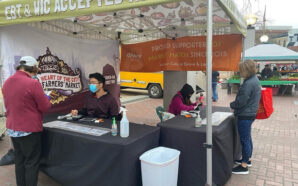Jenny Manrique
Ethnic Media Services
After caring for numerous members of Hispanic families who one by one fell ill in the face of the rapid spread of COVID-19, Dr. Verónica Ramírez of the Martin Luther King Community Hospital in Los Angeles saw the opportunity to get vaccinated as a way to, “be an example to begin to take control of this pandemic.”
“I have personally seen how this disease has affected our community,” said Ramírez, who has already received the two injections of the Pfizer-BioNTech vaccine, after which she was left with “a slight pain in the arm, a little fatigue and a headache.”
Ramírez spoke to Hispanic media, within the framework of the Vaccinate All 58 campaign that seeks to vaccinate all residents of the 58 California counties. To date, more than a million Californians have already received the free vaccine against COVID-19 and mega vaccination centers have opened in places like Dodger Stadium, Petco Park and Cal Expo.
“We know that there may be minor side effects after vaccination, but these are not harmful, they are a sign that the immune response is working,” said Ramírez. After her inoculation process, the doctor continues to use a mask and eye protection when treating COVID patients because, as she explained, not only does it take time for the body to develop all the necessary antibodies to face the virus, but there are no solid studies that guarantee that vaccinated people cannot continue to transmit it.
“According to the Pfizer study after the first dose, the level of protection is 52% and after the second dose, it reaches 95% (protection) … it is important that people (after vaccination) continue to practice their precautions,” such as washing hands, wearing masks, and maintaining social distancing.
Both vaccines approved by the Food and Drug Administration (FDA) were tested in tens of thousands of adults of diverse backgrounds, including older adults and ethnic communities. In both cases, its effectiveness in developing immunity against the virus is 95%, which is why medical experts consider it “safe and effective.”
Clinical trials for the Pfizer / BioNTech vaccine – whose two doses must be administered at least 21 days apart in people over 16 years of age – included 13% Hispanics, 10% African Americans, 6% Asians, 1% of Native Americans and 45% of participants ages 56-85.
In the case of the Moderna vaccine – whose doses must be administered at least 28 days apart in people over 18 years of age – the population sample included 20% Hispanics, 10% African Americans, 4% Asians and 25% % of participants over 65 years of age.
“Vaccines are the hope of ending this pandemic,” said Dr. Tomás Aragón, director of the California State Department of Public Health, recalling that the population group most affected by COVID-19 is precisely the Latino community.
As of January 21, California had more than 3 million COVID 19 cases and more than 35,000 deaths. Of these numbers, 55% of the cases correspond to Latino patients up to 49 years of age, while 46% of the deaths are Hispanic, Aragón recalled.
“When hospitals are so affected and we have so many patients in intensive care, we have to cancel many services in health centers … The effect of this pandemic is profound, and the vaccine is free.”
The doctor also clarified that although new strains of the coronavirus may appear on which it is not yet known if the vaccine will be effective, with respect to the most recent B117 variant that appeared in the United Kingdom, current vaccines are effective.
He also explained that access to vaccines is for all people regardless of their immigration status or if they lack health insurance. The medical information provided by the medical centers is protected by law and is not shared with any other state or federal authority.
“We recognize that there are many myths that are spreading in our community, but it is important that we focus more on the true data,” observed Dr. Trinidad Solís of the Fresno County Public Health Department, whose information campaign has spread to rural areas without internet connectivity like Coachella.
Some Hispanics question why the vaccine was developed in record time. “You have to understand that a priority was made in the scientific and medical community to develop an effective vaccine because this pandemic is global … all resources were focused there,” said Solis.
Others even believe that inoculation can infect them with COVID and there are those who think that if they have already had coronavirus, they do not need to be vaccinated, which Solis reminds is an unknown factor how long the protection of natural immunity can last.
“If we want the pandemic to be over, inoculation protects not only us but our families,” said Solis, citing concerns a recent article in the Los Angeles Times that highlights the grim news that Latinos are dying at a rate 8 times higher than just two months ago due to COVID-19.
“The implementation plan now is to vaccinate those who are most at risk (over 65) and when the turn comes, people will be able to go to vaccination centers in the community, general practitioners, clinics and local pharmacies (to receive your turn),” Solis said.
Governor Gavin Newsom has laid out a phased vaccination plan. In Phase 1A currently in force, health workers and residents of nursing homes were the first to be vaccinated. In Phase 1B that has already begun, the over 65s and people at risk of exposure continue in the areas of education, child care, emergency services, food, and agriculture.
A second group of this phase will include people at risk of exposure in the areas of transportation and logistics, industrial, commercial, and residential, as well as the prison and homeless population.
And in Phase 1C, people between 50 and 64 years of age and those between 16 and 49 who have pre-existing conditions or disabilities that increase the risk of contracting COVID will be vaccinated.
“We are receiving 300 thousand supplies of vaccines every week and in the coming weeks that number will be higher… we also believe that in March we will have other approved vaccines (beyond Pfizer and Moderna),” said Dr. Aragón.
“The distribution process is fair and equitable,” he added.
The state established the website covid19.ca.gov to record the evolution of the pandemic and explain the phases and distribution of the vaccines.





